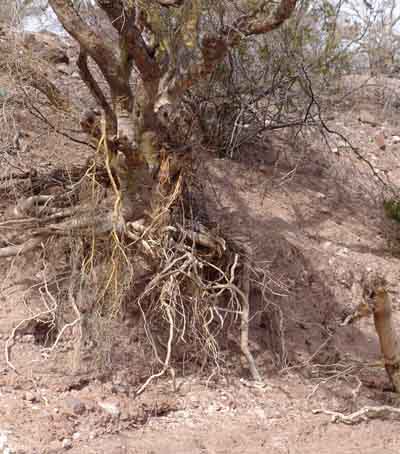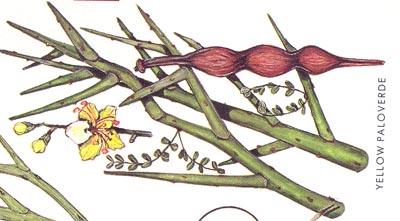|
Palo Verde (Cercidium
spp) is one of the major defining trees of our Arizona uplands -- a legume, with
leaf surface reduced nearly to zero to conserve moisture. Its leaves are twice-compound,
extremely small (see below left), and are shed entirely during dry periods.
The smooth greenish trunk and branches have largely taken over the photosynthetic
process. Palo Verdes may even shed some of their branches during drought, becoming
smaller trees -- they are "branch-deciduous" (and their wood is very
soft). These extraordinarily hardy trees provide much of the perennial greenness
to be found in Arizona desert (only rarely does an entire mature tree die from
drought). Palo Verdes bloom from March to May depending on elevation (and
rainfall). (The above banner photograph of Palo Verde-covered slopes on a Quiburis
terrace overlooking Lower Hot Springs Canyon was taken May 20, 2001.) The
following two varieties are native to our area, having arrived from the
south after the end of the Pleistocene, becoming fully established here about
4,500 years ago. A distribution map for the more common variety in our
area (the Foothill Paloverde), provided in Zimmerman
1969, shows it paralleling that of the Saguaro but somewhat more limited as to elevation.
Foothill Palo Verde ("yellow" or "green"): (microphyllum): a bristling, upright-branching tree, mostly found on desert slopes, it is one of the most widespread trees of the Sonoran Desert. Very slow-growing, they may live for several hundred years, and may rarely grow to heights of 25 to 30 feet (though 10 to 15 feet is more typical). Leaves are yellowish green, to 3/4" long; each leaf has one pair of major leaflets and 5 to 7 pairs of minor leaflets (see the validity of the "microphyllum" naming, left). Twigs themselves end as spines (none at nodes). Flowers erupt in masses, pale yellow but with one white petal (see illust. below), pistils may be reddish. They are pollinated by multiple species of Solitary Bees. Pods are narrow between seeds ("beaded"), 2-3" long. Bark is yellow-green. The Foothills species is shown here in all its typical, naked, bristly glory during the drought of May 2002 (top-left, mature; bottom-left, quite young), and erupted in bright yellow-green leaves after the rains in September (middle-left).
The Foothills root system spreads both wide and deep, enabling the tree to capture runoff on rocky hillsides where water penetrates through rock fissures and soil pockets; see this illustration of a small newly wash-exposed bush, below:

Here is an example from a much larger and older Palo Verde, at its wash-edge location
with roots exposed following the July 2003 floods in Soza Mesa Wash: Click on the image below for a larger view.

Further details including seeds and flowers are shown below: [Thanks to Petrides & Petrides, plates 20, 26.]

Blue Paloverde(floridum): a somewhat more drooping tree (left, click to enlarge), found mainly in desert washes, for example a number may be found along Sierra Blanca Spring Wash both below and above the spring. Not long after the end of the Pleistocene, when climate was wetter than today, Blue Palo Verde grew on the foothills where there are only Foothills Palo Verde now, because it requires substantially more water than the Foothills species. However, surprisingly it does survive in some uplands areas on Saguaro Juniper land -- quite a few may be seen along the Pool Wash Ridge Road at the tops of ridges which appear to us to be quite dry, as well as on hill slopes well above the Sierra Blanca Spring Wash.
Leaves are dull bluish green,to 1 1/2" long; 1 pair of major leaflets, each having 1 to 3 pairs of minor leaflets.Leaflets are noticeably larger and fewer in number than the Foothills. Twigs have a single straight thorn at each node (see left and below). Flowers bright golden yellow (without a white petal -- see illust. below), in loose clusters. Pods flattened, 3-4" long. Bark is blue-green:

Note also the difference in texture of the tree's crown from that of the Foothills
species -- it is more rounded and has many nearly horizontal branches. This is
apparent in the images at left.
|

